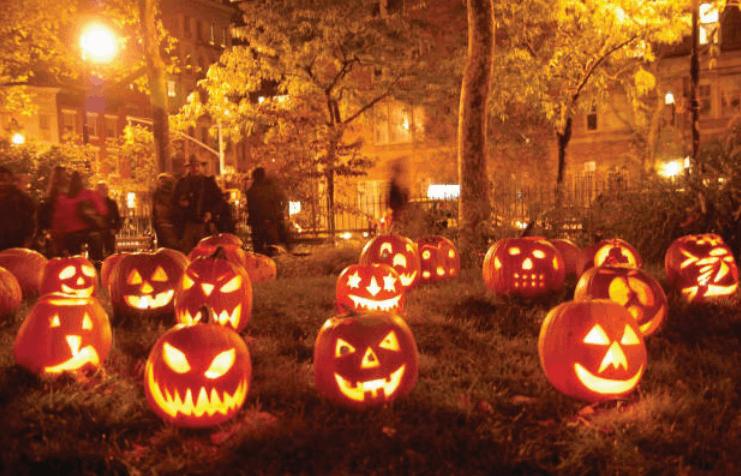英語ネイティブの翻訳者から、ハロウィーンの歴史について話を聞きました。
2020年10月26日 10時05分
※英語原文は日本語記事の下に掲載しています。
ハロウィーンは毎年10月31日に多くの国で祝われており、よく知られた祝日です。
この日は、コスチュームを身に付け、パーティーやパレードに参加し、
「トリック・オア・トリート」をしに行くのが、一般的な祝い方です。
このような現在の祝い方は、様々な文化や宗教の
古来の伝統に由来を持つものが多くあります。
ハロウィーンの歴史は、2000年前のSamhain(sow-winと発音します)
というケルトのお祭りに遡ります。
このお祭りは、収穫の終わりと長く暗い冬のはじまりを示すものでした。
この日は幽霊や霊魂が地上に戻ってくるとされており、
その存在のおかげで占いもよく当たる時期であると信じられていました。
ケルト人は大かがり火を焚き、作物と牛を生贄にし、
動物の頭や皮を使った衣装を身にまといました。
この伝統が、現在私たちがハロウィーンとして
認識している祝日を形作ることになったのには、
おそらくキリスト教の影響が大きな役割を果たしているでしょう。
西暦1000年までに、11月1日はすべての聖人を称える
「諸聖人の日」と定められ、Samhainのいくつかの伝統が融合したものとなりました。
この日はオール・ハロウズ(All Hallows)としても知られるようになり、
10月31日がオール・ハロウズ・イヴ(All Hallow's Eve)、
のちにハロウィーンとなりました。
ハロウィーンの祝日は、アメリカへ大量にやってきたアイルランド移民が
ジャックオランタンのような迷信や風習をもたらしたことにより、
1800年代半ばに全米に普及するようになりました。
私たちが今日知っているハロウィーンは、20世紀初頭までに誕生しました。
ハロウィーンを祝うことに、宗教的、迷信的な意味合いはほとんどなくなり、
遊び、季節の食べ物、お祭り衣装に力を入れるようになりました。
今日現在、カナダと米国ではクリスマスに続き、
2番目に多く祝われる休日となっています。

ハロウィーンの背景には、様々な文化や宗教に関係する、
長く入り組んだ歴史があります。
ハロウィーンは毎年10月31日に多くの国で祝われており、よく知られた祝日です。
この日は、コスチュームを身に付け、パーティーやパレードに参加し、
「トリック・オア・トリート」をしに行くのが、一般的な祝い方です。
このような現在の祝い方は、様々な文化や宗教の
古来の伝統に由来を持つものが多くあります。
ハロウィーンの歴史は、2000年前のSamhain(sow-winと発音します)
というケルトのお祭りに遡ります。
このお祭りは、収穫の終わりと長く暗い冬のはじまりを示すものでした。
この日は幽霊や霊魂が地上に戻ってくるとされており、
その存在のおかげで占いもよく当たる時期であると信じられていました。
ケルト人は大かがり火を焚き、作物と牛を生贄にし、
動物の頭や皮を使った衣装を身にまといました。
この伝統が、現在私たちがハロウィーンとして
認識している祝日を形作ることになったのには、
おそらくキリスト教の影響が大きな役割を果たしているでしょう。
西暦1000年までに、11月1日はすべての聖人を称える
「諸聖人の日」と定められ、Samhainのいくつかの伝統が融合したものとなりました。
この日はオール・ハロウズ(All Hallows)としても知られるようになり、
10月31日がオール・ハロウズ・イヴ(All Hallow's Eve)、
のちにハロウィーンとなりました。
ハロウィーンの祝日は、アメリカへ大量にやってきたアイルランド移民が
ジャックオランタンのような迷信や風習をもたらしたことにより、
1800年代半ばに全米に普及するようになりました。
私たちが今日知っているハロウィーンは、20世紀初頭までに誕生しました。
ハロウィーンを祝うことに、宗教的、迷信的な意味合いはほとんどなくなり、
遊び、季節の食べ物、お祭り衣装に力を入れるようになりました。
今日現在、カナダと米国ではクリスマスに続き、
2番目に多く祝われる休日となっています。

ハロウィーンの背景には、様々な文化や宗教に関係する、
長く入り組んだ歴史があります。
~編集後記~
ハロウィーンというと、日本では最近、渋谷のお祭り騒ぎが有名ですが、ハロウィーンのイベントに力を入れる人とそうでない人、様々だと思います。私は後者ですが、今回の記事でハロウィーンの歴史を知り、興味が湧いてきました。ハロウィーンの起源となったSamhain祭について、もう少し詳しく調べてみたいと思います。
(英語原文)
Halloween
Halloween is a popular holiday celebrated in many countries every year on October 31st. On this day, people generally celebrate by donning costumes, attending parties and parades, and going trick-or-treating. Many of these modern activities have their roots in ancient traditions from various cultures and religions.
The history of Halloween dates back to some 2000 years ago, to the Celtic celebration of Samhain (pronounced “sow-win”). This festival marked the end of the harvest and the beginning of the long dark winter. It was also believed that ghosts and spirits returned to earth on this day, and that their presence made fortune-telling easier. The Celts commemorated Samhain by lighting huge communal bonfires, sacrificing crops and cattle, and dressing in costumes of animal heads and skins.
Perhaps Christian influence played the biggest role in shaping this tradition into the holiday we know today. By 1000 A.D., November 1st was designated as All Saints’ Day, a day to honor all saints, and it incorporated some traditions of Samhain. This day was also known as All Hallows, making October 31st All Hallows Eve, and later Halloween.
The holiday finally started gaining national popularity in America in the mid-1800, thanks to the flood of Irish immigrants who brought their new superstitions and customs, like the jack-o’-lantern. By the beginning of the 20th century, Halloween as we know it today was born. Celebrations lost most of their religious and superstitious overtones, focusing more on games, seasonal foods, and festive costumes. As of today, it closely follows Christmas as the second-most celebrated holiday in Canada and the US.
(写真上記)
There is a long, tangled history behind Halloween involving many different cultures and even religions.
Halloween is a popular holiday celebrated in many countries every year on October 31st. On this day, people generally celebrate by donning costumes, attending parties and parades, and going trick-or-treating. Many of these modern activities have their roots in ancient traditions from various cultures and religions.
The history of Halloween dates back to some 2000 years ago, to the Celtic celebration of Samhain (pronounced “sow-win”). This festival marked the end of the harvest and the beginning of the long dark winter. It was also believed that ghosts and spirits returned to earth on this day, and that their presence made fortune-telling easier. The Celts commemorated Samhain by lighting huge communal bonfires, sacrificing crops and cattle, and dressing in costumes of animal heads and skins.
Perhaps Christian influence played the biggest role in shaping this tradition into the holiday we know today. By 1000 A.D., November 1st was designated as All Saints’ Day, a day to honor all saints, and it incorporated some traditions of Samhain. This day was also known as All Hallows, making October 31st All Hallows Eve, and later Halloween.
The holiday finally started gaining national popularity in America in the mid-1800, thanks to the flood of Irish immigrants who brought their new superstitions and customs, like the jack-o’-lantern. By the beginning of the 20th century, Halloween as we know it today was born. Celebrations lost most of their religious and superstitious overtones, focusing more on games, seasonal foods, and festive costumes. As of today, it closely follows Christmas as the second-most celebrated holiday in Canada and the US.
(写真上記)
There is a long, tangled history behind Halloween involving many different cultures and even religions.



